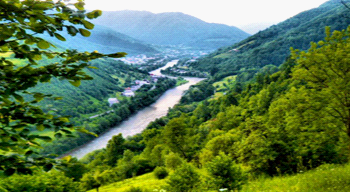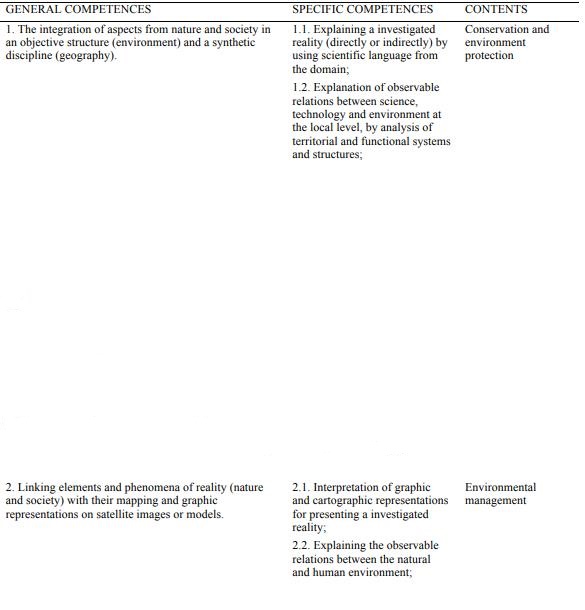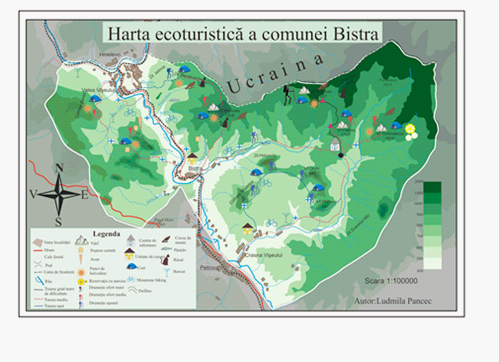Abstract
This paper aims to highlight the positive aspects of the application of modern methods of teaching and learning in studying ecotourism and sustainable development in local and regional horizon. We will present the importance of using modern teaching methods in teaching and studying ecotourism and sustainable development in local horizon, choosing for this Maramures region. In our research, we stopped on the Biosferei Reservation area – “Poiana cu Narcise” from Bistra village. An important aspect regarding the location of Bistra is that it lies at a distance of approximately 42 km from the so-called geographical center of Europe (Dilove town, Rahiv district, Zakarpatya region - Ukraine), it is an opportunity for Bistra village, capitalizing this, and the town can become a major European tourist attraction pole. For ecotourism, different plant species are natural attractions, interesting in that their ecosystems are untouched. The research was conducted with the help of a small group of undergraduates from the Geography of Tourism (Faculty of Geography – Babes-Bolyai University) from Bistrita extension during their teaching practice in an optional activity at the eleventh grade students from Bistrita Sports High School, in the second semester, year 2014.
Keywords: Reservationbiosphereeco-tourismteaching practiceattraction
1.Introduction
Bistra commune is situated in the northern part of Maramures County at the Romanian-Ukrainian
border. This territory extends on both units relief, Maramures Mountains and Maramures Depression.
Mostly, Bistra village include the lower course of the river Viseu and its tributaries, and the village Valea
Vişeului is found at the confluence of Viseu with Tisa (Marin et al., 2002).
From the administrative point of view, Bistra commune consists of three villages: Bistra located at
the confluence of Bistra river with the Viseu River, Crasna Vişeului located along the valley Frumuşaua
and village Valea Vişeului located at the confluence of Viseu with Tisa.
Ecotourism is heavily dependent of the quality of the environment.
In developing of the ecotourism products should be considered, in general, the eco-tourists have a
high educational potential. Therefore, and their expectations are much higher and achieve a product that
meets those expectations is essential.
Education facilitates awareness that behavior changes toward accountability, participation,
involvement in specific ecotourism activities are possible and that there are other ways to organize
specific activities in the field. The education and awareness on the importance of nature conservation, as
well as understanding and respecting the principles of ecotourism must start from local communities and
visitors, but they must continue between local and central government.
2. Material and method
The position of Bistra commune in the area of Maramures Mountains and two major rivers of
Maramuresului Land, determines the relief structure and the variety and type of vegetation, fauna and
lack of pollution sources. Therefore this village benefit of picturesque places, with a favorable climate to
recreation and leisure.
The relief units from Bistra village landscape have a particularly attractive aspect, affordable, long
ridges that offer the possibility of developing ecotourism and rural tourism. From an altimetry report, the
altitude levels are between 330 m at the confluence of Tisa with Vişeu and 1937 m, at Pop Ivan Peak.
From geological point of view, are predominantly crystalline schist’s and igneous rocks, sandstone, marl
and conglomerates.
Vegetation on the territory of Bistra is rich and very diverse, represented on altitude floors depending
of several key factors, such as climate, soil, slopes, lithological substrate. For ecotourism, different plant
species are natural attractions, interesting in that their ecosystems is untouched. Bistra hydrography is
represented by two major rivers of Maramures Country, Viseu River and Tisa River each with its
tributaries (see Viseu River in figure

In the top of tourism activities in Maramures Mountains Natural Park and Poiana cu Narcise Biosphere
Reservation on Bistra area is the pedestrian hiking and horse trekking. Many hikers are venturing on the
Pop Ivan, Şerban, Poloninca and Muncelul massive for their natural beauty, and for natural lookout points
that provide these mountain massifs. Poiana cu Narcise Reserve involves not only hiking to daffodils but
also observing and analyzing these flowers blossom and observing other wildlife and birds (Marin et al.,
2002).
In both protected areas, photo-safari is practiced, any tourist or resident willing recreation and
adventure, armed with a camera but without motors, captures scenic landscapes, mountain flora, wildlife
caught unawares, so practicing two ecotourism activities (Nistoreanu, 2006).
In the village Bistra the protected areas are valued by the practice of cycle tourism and mountain
biking, e.g. on the Tocarnea, Luhei, Paltinu Tomnatecu peaks, bike tourists were surprised. The activities
mentioned are not the only activities that can be practiced in protected areas of Bistra village.
Natural tourism potential occupies a major proportion compared with anthropic potential, for making a
ministration for all four seasons is necessary to perform in various points of exploiting the natural tourism
resources; hiking trails, lookout points, observation points of the fauna and flora, accommodation cabins,
camping areas, slopes for skiing, recreation zones on the river valleys.
General and specific competencies, which are formed in high school through the centered educational
process, based on geography, promote the following values and attitudes:
Positive attitude towards education, knowledge, society, culture, civilization;
Curiosity to explore the geographical environment;
Respect for the natural and human diversity;
Environmental protection and preservation of life.
Cartographic competence interferes with another v competence, of very highest level: understanding of
objective reality, as a result of interaction between nature and society and notification that geography is
the science dealing with it. The two competences should be complementary (given that there are great
possibilities for practicing other skills) (Mândruţ et al., 2009).
The general and specific competences monitored in the study are shown in the table 1.

methods is that they promote interaction between participant’s minds, of their personalities, leading to a
more active learning and obvious results (Chiş, 2002)
In this regard, we chose brainstorming which has as scope that student to interact between them, to
generate new ideas and at the same time to assimilate new knowledge (Iucu & Pânişoară, 2000; Neacşu,
2000).
Brainstorming or "delayed assessment" or "brain storm" is an interactive method of developing
new ideas arising from discussions between several participants, each of which comes with many
suggestions. The outcome of these discussions, results in choosing the best solutions to the discussed
situation. As a method of creative discussion, in-group, brainstorming was systematized in 1948 by
Alexander Osborn professor from Buffalo University (USA).
The method “assault of ideas" or "waterfall ideas" aims issuing a large number of solutions, ideas
on how to solve a problem in the hope that, by combining them will get the optimal solution. The path for
obtaining these ideas is to stimulate creativity within the group, in an atmosphere free of criticism,
uninhibitory result of postponing the moment of evaluation (Cucoş, 2000).
Brainstorming are conducted in meetings formed from not very large groups (30 people
maximum), preferably heterogeneous in terms of training and occupation, under the direction of a
moderator, who acts as both an animator and the mediator (Păun, 2002). The optimal duration is 20-45
minutes.
Specific to this method is that it includes two moments: one for the production of ideas and then
their evaluation (Phase of critical assessments).
To initiate a brainstorming session, we propose the following steps and phases:
1. Preparation phase which includes: a) the investigation phase and the selection of members of
the creative group; b) creative training phase; c) preparation of working sessions;
2. Productive phase, the issuance of creative alternatives, which includes: a) the establishment of
the working theme, debated issues; b) phase of solving the formulated problems;
c) Additional ideas gathering phase, necessary for continuing a creative approach;
3. Selection of issued ideas phase that favors critical thinking: a) the analysis phase of the ideas
emitted by that time; b) critical assessment phase and choosing the final solution
Students organized in two groups will choose one leader who will represent them in front of the
classroom, chosen leader will come on board to write down their outlined ideas.
Step I:
We issue the topic for discussion, coordinate discussions, intervene to correct. Each student
presents his ideas, which the group leader notes on an A4 sheet, both groups follow this process.
Step II:
Students receive a series of cartographic representations that have to analyze, to know the icons
and to realize what ecotourism activities are represented in the studied material. These maps will help
them to identify new ideas about ecotourism and for reading and interpreting tourist maps (see figure

Cartographic competence interferes with another competence, of very highest level: the
understanding of reality objective because of interaction between nature and society and notification that
geography is the science that deals with this. The two competences should be complementary skills
(Mândruţ et al., 2009).
This method allows us to represent in colors the areas of common items (i.e. the area where you
can practice various ecotourism activities or you can set goals for practicing various touristic activities)
and in addition on the holder of the colorful map may be placed conventional signs and the symbols of
different points of interest and activities.
Step III:
After knowing the area under study (Bistra) from the map, according to hypsometric tints,
altitudes scale (e.g. vegetation, fauna, and flora) identification of ecotourism activities, familiarity with
terms of conservation, protection, ecotourism, and students will receive also photo materials. Will use
these to see how it is practiced some ecotourism activities in Bistra village and will receive some plans
for sustainable development of the village valuing and protecting the environment.
Step IV:
Students (leader) are asked to submit their ideas on the board for final debate (consolidation of
new knowledge).
Were made sheets with student ideas contained in two columns:
A – The ecotourism column made by students achieved in most cases: making trips, nature
conservation, practicing cycling activity, observation and protection of habitats ... etc.
B – The sustainable development column made by students in most cases provides community
recreation camps, arranging some mixed area of reservations etc.
3. Results and discussions
First, by combining a brainstorming with the application of cartographic methods in a lesson at XI
class, I could demonstrate the importance of these methods for teaching and learning geography through
the following positive effects: a
• Brainstorming method gave pupils the opportunity to express their ideas freely and argue the
stated theme;
The group work gave students the opportunity to divide opinions, experiences and ideas;
It minimized the phenomenon of emotional blockage of creativity;
Cartographic method encouraged students to be more creative and ask questions;
Through the cartographic method I noticed that students have developed a sense of
geographically specific spatial orientation;
Second on that occasion may give some suggestions regarding the use of effective methods for other
geography lessons.
• Since a group gives a sense of trust, security and mutually involves the members, we
recommend that teacher to bring together students into small groups (3-4 for example instead of 15);
• The collective interaction has the effect "of self-education and a tolerant behavior regarding the
point of views of others, overcome subjectivism and accept collective thinking, so teacher to motivate
students and to issue critical ideas.
• From experience I can say that it is very useful for the teacher to use brainstorming and photo
materials, stimulates discussions, for the next lesson of this type before the discussion, is recommended
that students to watch a short movie about the theme.
4. Conclusions
Is very important the positive impact of tourism on the environment, tourism is one of the most
important industries and experiences a continuing development. Thus, areas, which have great natural
resources, attract more and more visitors especially if they offer the opportunity to know the traditions
and customs. When tourism and environment coexist in harmony, the environment benefits from tourism.
There are many examples of this kind, most falling into one of two types: environmental conservation and
rehabilitation, they often go hand in hand.
The advantages of brainstorming method are multiple. Among them are:
- Quick and easy to obtain new ideas and solutions;
- Reduced costs for use of the method;
- Broad applicability in almost all areas; - Promotes active participation and creates the possibility of
contagion of ideas;
- Develop creativity, spontaneity, self-confidence through the delayed assessment process;
- Develop the ability to work in teams;
Limits of brainstorming: do not complement the enduring research, classical; depend of moderator
qualities to animate and direct discussion on desired track; only offers possible solutions does not solve
the problem; sometimes it can be too tiring for some participants.
Pedagogical competence is a range of qualities, skills, abilities, traits, ensuring efficiency of teaching,
not as a dramatic presence of either component, and especially by mainstreaming their resultant. The
actual teaching triggers most traits and skills that are a measure of efficiency.
References
- Chis, V. (2002). Challenges of contemporary pedagogy. University Press Publishing. Cluj-Napoca, p.33 Cucoş, C. (2000). Pedagogy, Polirom Publishing House, Iasi, 46.
- Iucu, R. & Pânişoară, I.O. (2000). Training teachers. First and Second Research Report, Ministry of Education. National Council for Teacher Training, 21.
- Marin, I., et al. (2002). Gestiunea durabilă a peisajelor geografice prin organizare şi amenajare regională. Ars Docendi Publishing House. Bucharest, 34-35.
- Mândruţ, O. & Ilinca, N. & Pârvu, Cristina (2009). Competenţele în învăţarea geografiei (training support for geography inspectors counseling – Târgu Secuiesc, 2 – 3 September 2009), 11.
- Neacşu, N. (2000). Turismul şi dezvoltarea durabilă. Expert Publishing House. Bucharest, 52.
- Nistoreanu, P. (2006). Ecoturism şi turism rural. Economică Publishing House. Bucharest, 43.
- Păun, E. (2002). Professionalization of teaching in Professional standards teaching profession. MEC. Bucharest, 20-25.
Copyright information

This work is licensed under a Creative Commons Attribution-NonCommercial-NoDerivatives 4.0 International License.
About this article
Publication Date
25 May 2017
Article Doi
eBook ISBN
978-1-80296-022-8
Publisher
Future Academy
Volume
23
Print ISBN (optional)
-
Edition Number
1st Edition
Pages
1-2032
Subjects
Educational strategies, educational policy, organization of education, management of education, teacher, teacher training
Cite this article as:
Sabo, H. M., & Muresianu, M. (2017). Importance Of Ecotourism At Students In Teaching Practice. In E. Soare, & C. Langa (Eds.), Education Facing Contemporary World Issues, vol 23. European Proceedings of Social and Behavioural Sciences (pp. 32-38). Future Academy. https://doi.org/10.15405/epsbs.2017.05.02.5

